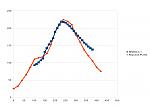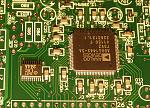loading surface mount IC's
Posted 1st July 2012 at 12:21 PM by googlyone
One thing that always used to give me grief at home was loading fine pitch surface mount IC's.
I recently bought a toaster oven having read several people's experience using these to relow SMD's.
I lashed out and bought the el-expensivo fan forced model, as this was in one forum reported to give more even heat. After some playing around I concluded the oven would actually be really very good.
I found that if I did the following (with my oven):
- Turn on and run on 2 bars until temperature = 100C,
- Turn down to one bar, and run for 60 seconds,
- Turn on two bars and continue until the temperature is 210C,
- Turn all bars off, leave fan on and open the door a crack.
The heat continues to increase to about 220, and the profile is really very close to many manufacturers recommended profiles.

I don't use silksceeens, I use a syringe and put a very little paste under the pads. This is something I am working on.
The real intent here is to show a trick I have started using in inspection...
Inspecting 0.5mm lead pitch components using anything but a microscope (which I used to have at work, and was REALLY good) is a lot harder than you might think.
Then I took a photo...

I was amazed at the detail you can get taking a macro photo of the board. It sure takes an awful lot of the squinting and mucking around with microscopes out of the task!
On the downside it let me see just how oxidised the bypass capacitors were. If I had seen these before I reflowed the board I would have turfed them and used new ones. While they seem to have soldered OK, there is some evidence of variable wetting of the caps. Bugger.
I recently bought a toaster oven having read several people's experience using these to relow SMD's.
I lashed out and bought the el-expensivo fan forced model, as this was in one forum reported to give more even heat. After some playing around I concluded the oven would actually be really very good.
I found that if I did the following (with my oven):
- Turn on and run on 2 bars until temperature = 100C,
- Turn down to one bar, and run for 60 seconds,
- Turn on two bars and continue until the temperature is 210C,
- Turn all bars off, leave fan on and open the door a crack.
The heat continues to increase to about 220, and the profile is really very close to many manufacturers recommended profiles.

I don't use silksceeens, I use a syringe and put a very little paste under the pads. This is something I am working on.
The real intent here is to show a trick I have started using in inspection...
Inspecting 0.5mm lead pitch components using anything but a microscope (which I used to have at work, and was REALLY good) is a lot harder than you might think.
Then I took a photo...

I was amazed at the detail you can get taking a macro photo of the board. It sure takes an awful lot of the squinting and mucking around with microscopes out of the task!
On the downside it let me see just how oxidised the bypass capacitors were. If I had seen these before I reflowed the board I would have turfed them and used new ones. While they seem to have soldered OK, there is some evidence of variable wetting of the caps. Bugger.
Total Comments 0




